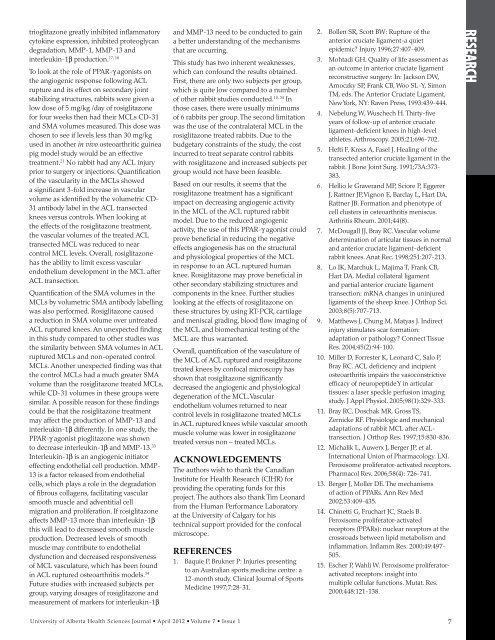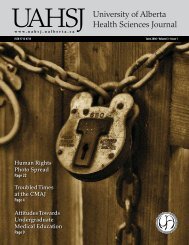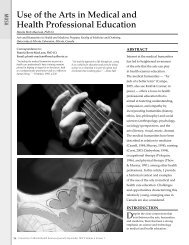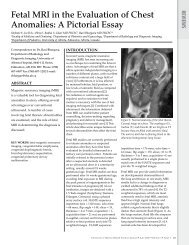Complete Issue PDF - University of Alberta Health Sciences Journal
Complete Issue PDF - University of Alberta Health Sciences Journal
Complete Issue PDF - University of Alberta Health Sciences Journal
- No tags were found...
Create successful ePaper yourself
Turn your PDF publications into a flip-book with our unique Google optimized e-Paper software.
trioglitazone greatly inhibited inflammatorycytokine expression, inhibited proteoglycandegradation, MMP-1, MMP-13 and17, 18interleukin-1β production.To look at the role <strong>of</strong> PPAR-γ agonists onthe angiogenic response following ACLrupture and its effect on secondary jointstabilizing structures, rabbits were given alow dose <strong>of</strong> 5 mg/kg /day <strong>of</strong> rosiglitazonefor four weeks then had their MCLs CD-31and SMA volumes measured. This dose waschosen to see if levels less than 30 mg/kgused in another in vivo osteoarthritic guineapig model study would be an effectivetreatment. 21 No rabbit had any ACL injuryprior to surgery or injections. Quantification<strong>of</strong> the vascularity in the MCLs showeda significant 3-fold increase in vascularvolume as identified by the volumetric CD-31 antibody label in the ACL transectedknees versus controls. When looking atthe effects <strong>of</strong> the rosiglitazone treatment,the vascular volumes <strong>of</strong> the treated ACLtransected MCL was reduced to nearcontrol MCL levels. Overall, rosiglitazonehas the ability to limit excess vascularendothelium development in the MCL afterACL transection.Quantification <strong>of</strong> the SMA volumes in theMCLs by volumetric SMA antibody labellingwas also performed. Rosiglitazone causeda reduction in SMA volume over untreatedACL ruptured knees. An unexpected findingin this study compared to other studies wasthe similarity between SMA volumes in ACLruptured MCLs and non-operated controlMCLs. Another unexpected finding was thatthe control MCLs had a much greater SMAvolume than the rosiglitazone treated MCLs,while CD-31 volumes in these groups weresimilar. A possible reason for these findingscould be that the rosiglitazone treatmentmay affect the production <strong>of</strong> MMP-13 andinterleukin-1β differently. In one study, thePPAR-γ agonist pioglitazone was shownto decrease interleukin-1β and MMP-13. 33Interleukin-1β is an angiogenic initiatoreffecting endothelial cell production. MMP-13 is a factor released from endothelialcells, which plays a role in the degradation<strong>of</strong> fibrous collagens, facilitating vascularsmooth muscle and adventitial cellmigration and proliferation. If rosiglitazoneaffects MMP-13 more than interleukin-1βthis will lead to decreased smooth muscleproduction. Decreased levels <strong>of</strong> smoothmuscle may contribute to endothelialdysfunction and decreased responsiveness<strong>of</strong> MCL vasculature, which has been foundin ACL ruptured osteoarthritis models. 34Future studies with increased subjects pergroup, varying dosages <strong>of</strong> rosiglitazone andmeasurement <strong>of</strong> markers for interleukin-1βand MMP-13 need to be conducted to gaina better understanding <strong>of</strong> the mechanismsthat are occurring.This study has two inherent weaknesses,which can confound the results obtained.First, there are only two subjects per group,which is quite low compared to a number<strong>of</strong> other rabbit studies conducted. 10, 34 Inthose cases, there were usually minimums<strong>of</strong> 6 rabbits per group. The second limitationwas the use <strong>of</strong> the contralateral MCL in therosiglitazone treated rabbits. Due to thebudgetary constraints <strong>of</strong> the study, the costincurred to treat separate control rabbitswith rosiglitazone and increased subjects pergroup would not have been feasible.Based on our results, it seems that therosiglitazone treatment has a significantimpact on decreasing angiogenic activityin the MCL <strong>of</strong> the ACL ruptured rabbitmodel. Due to the reduced angiogenicactivity, the use <strong>of</strong> this PPAR-γ agonist couldprove beneficial in reducing the negativeeffects angiogenesis has on the structuraland physiological properties <strong>of</strong> the MCLin response to an ACL ruptured humanknee. Rosiglitazone may prove beneficial inother secondary stabilizing structures andcomponents in the knee. Further studieslooking at the effects <strong>of</strong> rosiglitazone onthese structures by using RT-PCR, cartilageand meniscal grading, blood flow imaging <strong>of</strong>the MCL and biomechanical testing <strong>of</strong> theMCL are thus warranted.Overall, quantification <strong>of</strong> the vasculature <strong>of</strong>the MCL <strong>of</strong> ACL ruptured and rosiglitazonetreated knees by confocal microscopy hasshown that rosiglitazone significantlydecreased the angiogenic and physiologicaldegeneration <strong>of</strong> the MCL. Vascularendothelium volumes returned to nearcontrol levels in rosiglitazone treated MCLsin ACL ruptured knees while vascular smoothmuscle volume was lower in rosiglitazonetreated versus non – treated MCLs.ACKNOWLEDGEMENTSThe authors wish to thank the CanadianInstitute for <strong>Health</strong> Research (CIHR) forproviding the operating funds for thisproject. The authors also thank Tim Leonardfrom the Human Performance Laboratoryat the <strong>University</strong> <strong>of</strong> Calgary for histechnical support provided for the confocalmicroscope.REFERENCES1. Baquie P, Brukner P: Injuries presentingto an Australian sports medicine centre: a12‐month study. Clinical <strong>Journal</strong> <strong>of</strong> SportsMedicine 1997;7:28‐31.2. Bollen SR, Scott BW: Rupture <strong>of</strong> theanterior cruciate ligament-a quietepidemic? Injury 1996;27:407‐409.3. Mohtadi GH. Quality <strong>of</strong> life assessment asan outcome in anterior cruciate ligamentreconstructive surgery: In: Jackson DW,Arnoczky SP, Frank CB, Woo SL-Y, SimonTM, eds. The Anterior Cruciate Ligament,New York, NY: Raven Press, 1993:439-444.4. Nebelung W, Wuschech H. Thirty-fiveyears <strong>of</strong> follow-up <strong>of</strong> anterior cruciateligament-deficient knees in high-levelathletes. Arthroscopy. 2005;21:696-702.5. Hefti F, Kress A, Fasel J. Healing <strong>of</strong> thetransected anterior cruciate ligament in therabbit. J Bone Joint Surg. 1991;73A:373-383.6. Hellio le Graverand MP, Sciore P, EggererJ, Rattner JP, Vignon E, Barclay L, Hart DA,Rattner JB. Formation and phenotype <strong>of</strong>cell clusters in osteoarthritis meniscus.Arthritis Rheum. 2001;44(8).7. McDougall JJ, Bray RC. Vascular volumedetermination <strong>of</strong> articular tissues in normaland anterior cruciate ligament-deficientrabbit knees. Anat Rec. 1998;251:207-213.8. Lo IK, Marchuk L, Majima T, Frank CB,Hart DA. Medial collateral ligamentand partial anterior cruciate ligamenttransection: mRNA changes in uninjuredligaments <strong>of</strong> the sheep knee. J Orthop Sci.2003;8(5):707-713.9. Matthews J, Chung M, Matyas J. Indirectinjury stimulates scar formation:adaptation or pathology? Connect TissueRes. 2004;45(2):94-100.10. Miller D, Forrester K, Leonard C, Salo P,Bray RC. ACL deficiency and incipientosteoarthritis impairs the vasoconstrictiveefficacy <strong>of</strong> neuropeptide Y in articulartissues: a laser speckle perfusion imagingstudy. J Appl Physiol. 2005;98(1):329-333.11. Bray RC, Doschak MR, Gross TS,Zernicke RF. Physiologic and mechanicaladaptations <strong>of</strong> rabbit MCL after ACLtransection.J Orthop Res. 1997;15:830-836.12. Michalik L, Auwerx J, Berger JP, et al.International Union <strong>of</strong> Pharmacology. LXI.Peroxisome proliferator-activated receptors.Pharmacol Rev. 2006;58(4): 726-741.13. Berger J, Moller DE. The mechanisms<strong>of</strong> action <strong>of</strong> PPARs. Ann Rev Med2002;53:409-435.14. Chinetti G, Fruchart JC, Staels B.Peroxisome proliferator-activatedreceptors (PPARs): nuclear receptors at thecrossroads between lipid metabolism andinflammation. Inflamm Res. 2000;49:497-505.15. Escher P, Wahli W. Peroxisome proliferatoractivatedreceptors: insight intomultiple cellular functions. Mutat. Res.2000;448:121-138.RESEARCH<strong>University</strong> <strong>of</strong> <strong>Alberta</strong> <strong>Health</strong> <strong>Sciences</strong> <strong>Journal</strong> • April 2012 • Volume 7 • <strong>Issue</strong> 1 7






